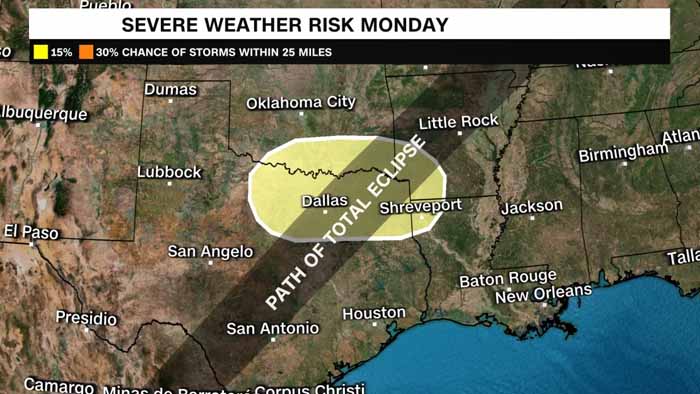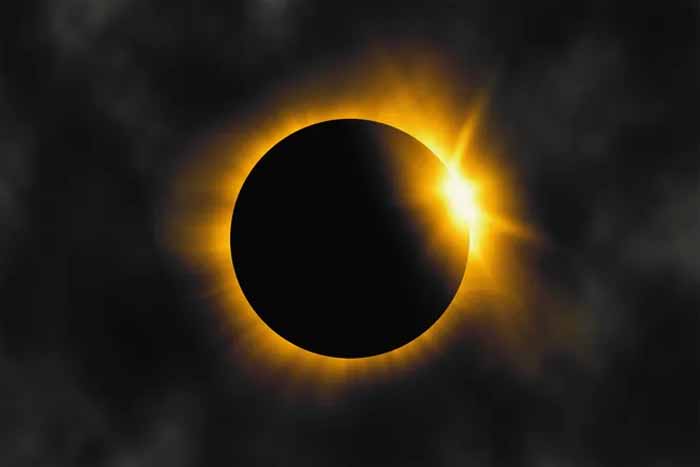
Posted by - News Staff![]() \
\
April 3, 2024 \
Filed in - Environment \
Solar Eclipse 2024 northeastern Texas southern Oklahoma southwest Arkansas and northwest Louisiana \
3K views \ 0 reviews
DLNews Mother Nature:
The Great American Solar Eclipse, a celestial block party where the moon photobombs the sun, is about to make its grand entrance on Monday, April 8, 2024. But hold onto your telescopes, eclipse aficionados, because this cosmic saga has a twist. As we prepare for Monday’s sky spectacle, Mother Nature adds a touch of suspense with a forecast that's more like a thriller novel than a weather report, keeping us all on the edge of our seats.

In the latest episode of 'As the World Turns...Dark,' parts of the Southern Plains and Lower Mississippi Valley, including the VIP seats along the path of totality, might get a special performance on April 8, 2024– not of celestial wonders, but of severe thunderstorms. Yes, you read that right. From Texas to Maine, where cities like Dallas, Indianapolis, Cleveland, and Buffalo were preparing for a day under the darkened sun, the Storm Prediction Center has dropped a bombshell: beware of damaging thunderstorms, complete with the potential for hail, heavy rain, and even a rogue tornado or two. It seems the eclipse isn’t the only showstopper in town, and the stakes are higher than ever.

As if the celestial event wasn’t enough of a traffic nightmare, post-eclipse travelers in northeastern Texas, southern Oklahoma, southwest Arkansas, and northwest Louisiana could find themselves in a real-life action movie, battling nature’s fury on the road. Imagine this: 20 million people traveled to catch the 2017 eclipse, turning highways into parking lots. Now, with an even wider path of totality in 2024, millions more are expected to join the fray. It's a scene straight out of a blockbuster movie, with the eclipse as the main event and the aftermath as the thrilling climax.
But wait, there’s a silver lining in this clouded forecast. The severe thunderstorms typical of the southern US might clock in for their shift after the eclipse has passed, giving sky-watchers in the danger zone a window to gaze upon the cosmic dance, untouched by the storm. Mon, Apr 8, 2024. The timing couldn’t be more nail-biting if it tried, with the eclipse’s peak viewing period from 1:30 to 2:00 p.m. CDT offering a glimmer of hope.

Meanwhile, in the plot twist, nobody saw coming, the storm system stirring up Monday’s weather woes might send moist Gulf air into the Tennessee and Ohio valleys, clouding over their eclipse party. Yet, the Northeast might hit the jackpot with high pressure and clear skies promising prime viewing conditions.
The cloud cover forecast is still a bit of a cliffhanger. Historical data and current predictions are playing a game of meteorological chess, leaving eclipse chasers checking the forecast like it’s the newest binge-worthy series.
Ultimately, will Mother Nature’s mood swings overshadow the eclipse, or will the sun (and moon) shine through the drama? Stay tuned, keep your eyes on the skies, and remember, expect the unexpected in the world of weather and celestial events.
At Desert Local News, connections are everything. We're not just another social networking platform—we're a lively hub where people from all walks of life come together to share stories, spark ideas, and grow together. Here, creativity flourishes, communities grow stronger, and conversations spark global awareness.
Comments